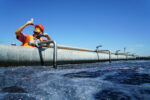Rebooting our climate: the sustainable energy transition
It is no exaggeration to say that the future of our society, of our way of life, possibly even of our planet itself, depends on our ability to halt and potentially reverse the impacts of climate change. Future generations are counting on us.
If we fail, our shared future looks bleak: Soaring temperatures. Melting ice caps. Rising sea levels. Succeed, however, and not only do we secure the future of our society, we open a whole new path towards a healthier, fairer and more sustainable way of life for the planet.
At the very center of this conundrum is energy. Without it, our civilization would collapse. But therein lies the problem. Electricity production is the single largest cause of atmospheric pollutants[1]. Worse – by 2050, we may need twice the amount of energy we presently consume[2].
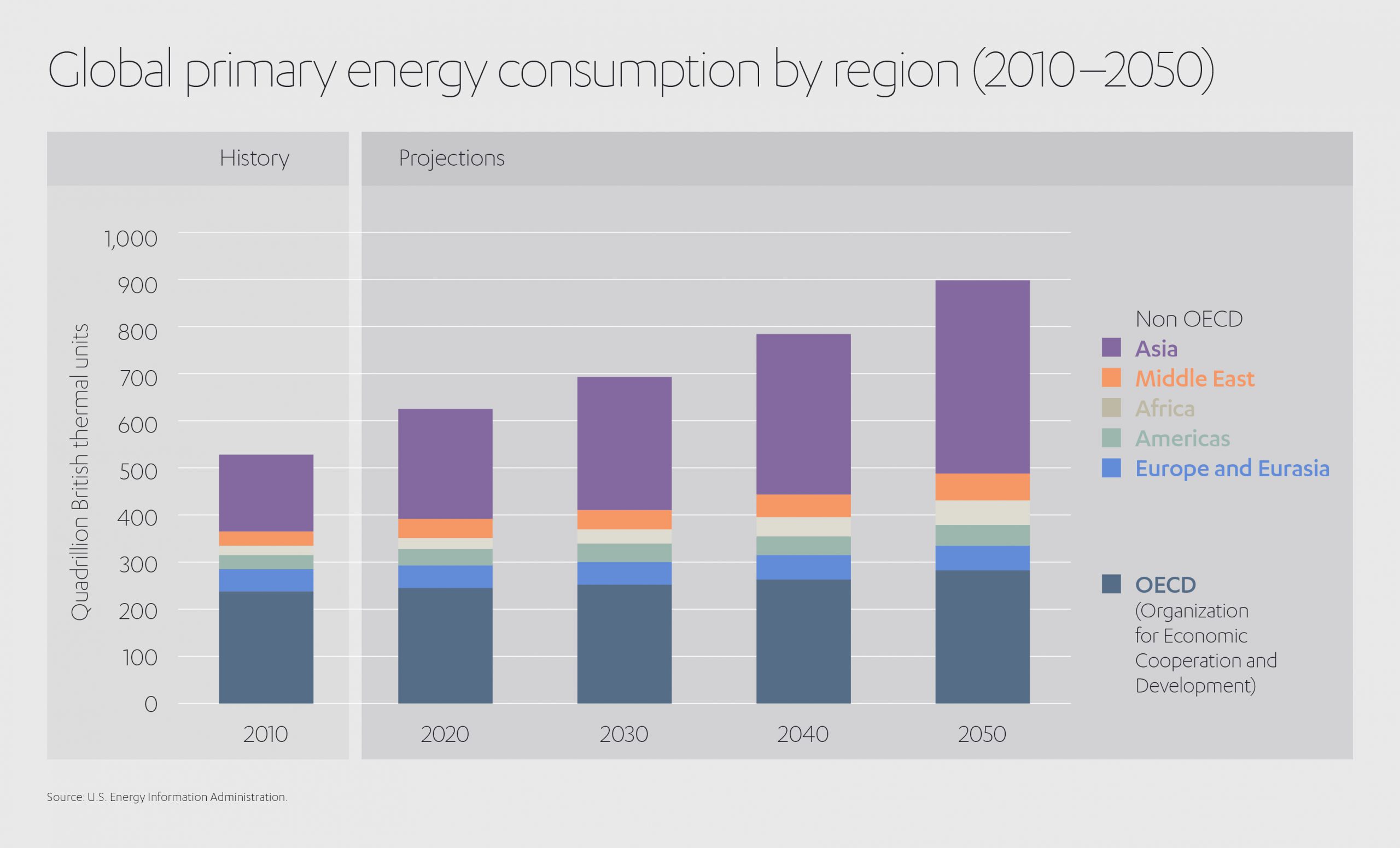
The scale of the challenge before us is unprecedented and global. Have we already passed, as some commentators claim, “Year Zero of the climate apocalypse”?[3]
Even with so much at stake, we find ourselves on collision course with one stark reality: our good intentions must be economically viable.
Fortunately, it is becoming increasingly hard to ignore the fact that, when it comes to renewable energies like wind and solar power, the math really does stack up. Less pollution doesn’t mean less profit, but more profit.
If money talks, let’s start listening
The time to definitively prove the economic case for renewable energy isn’t next year, nor even tomorrow. It is now. While we prevaricate, populations are suffering amid heatwaves, punishing tides and extreme weather.
And so to the good news. As discussed on our Spotlight article on the economic costs of climate change by Fady Jameel, Deputy President and Vice Chairman of Abdul Latif Jameel, business brains are well motivated to unite behind the green energy crusade.
- Two-hundred of the largest listed companies in the world estimate that the fallout from climate change will cost them a combined US$ 1 trillion.[4]
- The UN International Labor Organization expects work-related heat stress to reduce global working hours by the equivalent of 80 million jobs by 2030.[5]
- According to one calculation, natural disasters translate to a US$ 520 billion loss in annual consumption.[6]
- Without urgent remedial action an extra 100 million people will be forced into poverty by 2030 due to climate change.[7]
The smart money’s focused on green energy to save our environment and energize our post-pandemic economy. While biofuels and hydropower continue their steady ascent, it’s solar and wind power that are generating the real buzz. And it doesn’t take much digging to see how these technologies are already shaping up to electrify the market.
Burning ambition of solar pioneers
Solar’s soaring. The pandemic may have slowed down the roll-out of new PV (photo-voltaic) projects worldwide, but its momentum is stronger than any superbug.
 The International Energy Agency (IEA) sees global solar capacity nearing 200 GW by the end of 2021 – a new industry record[8]. Setting the pace are China, Europe and the USA, but it’s a truly global phenomenon: more than 30 countries now have in excess of 1 GW solar capacity, as explored in our Perspectives article on the rapid growth of the solar energy market. India and Japan will provide further rays of sunshine between now and 2030.
The International Energy Agency (IEA) sees global solar capacity nearing 200 GW by the end of 2021 – a new industry record[8]. Setting the pace are China, Europe and the USA, but it’s a truly global phenomenon: more than 30 countries now have in excess of 1 GW solar capacity, as explored in our Perspectives article on the rapid growth of the solar energy market. India and Japan will provide further rays of sunshine between now and 2030.
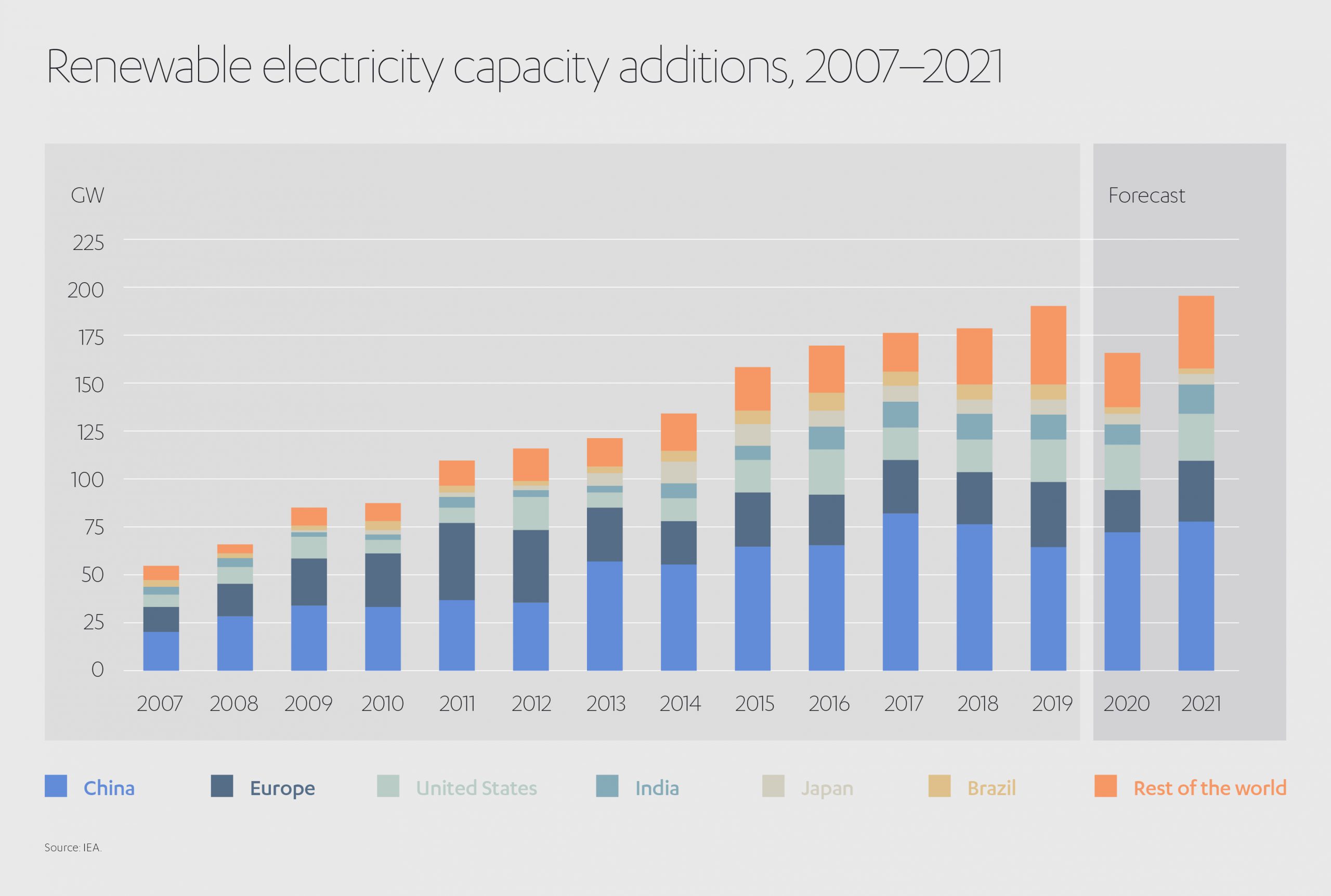
New deals are stealing headlines daily. See the UAE’s Rashid Al Maktoum IV project, the largest single-site Concentrated Solar Power (CSP) project in the world. Rashid Al Maktoum IV won US$ 4.2 billion financing for its latest expansion, incorporating not only the world’s highest solar tower, at 260 meters, but also the highest global thermal storage capacity, at 15 hours.[9]
See also the US$ 6 billion Leh and Kargil solar power plants in Jammu and Kashmir, India, which will connect to a transmission network extended 850km to Punjab and inject some 7.5GW of energy into the grid.
On the back of enormous investments like these, the IEA expects solar to fulfill one-fifth of global energy needs by 2040.[10]
We can feel the heat – can you?
At Abdul Latif Jameel, we have long recognized the potential of solar power. Now, via our flagship renewable energy business Fotowatio Renewable Ventures (FRV), we’re leading the solar surge with a growing portfolio of projects worldwide.
As a snapshot, take our progress in Australia. Our 67.8 MW Goonumbla Solar Farm in New South Wales began operating in 2019 and supplies more than 45,000 homes with clean energy, saving some 140,000 tons of CO2 annually; our 85 MW Winton solar farm in Victoria will generate 210,000 MWh of power each year; and our new venture with Snowy Hydro, the 90 MW Sebastopol solar farm in New South Wales, brings environmental benefits equating to 27,700 fewer cars on the road.
Consider also our growth in Mexico. Our Potosi Solar Plant in San Luis de Potosi began operating in 2019 and now generates 815,000 MWh of clean energy each year. Our second Mexican plant, the Potrero PV farm in Jalisco, is set to power 128,000 homes, saving 437,000 tons of CO2 annually.
We’re also plugged into the technological milestone which will prove a genuine game-changer: a breakthrough in batteries.
Next-gen batteries promise a power-up
Hyper-efficient batteries are the ‘holy grail’ for renewables, the ‘missing link’ if you like, filling the much-cited gap of what happens when he sun is not shining and the wind not blowing. This is a topic we look at in more depth in our Perspectives article on the latest innovations in battery technology. Utility-scale batteries allow power generated during productive periods to meet demand during other times. Energy storage is the field where many forward-thinking investors are plowing their funds – and where some of the biggest returns will be made.
Energy storage installations are predicted to multiply from 9 GW (2018) to an incredible 1,095 GW by 2040. For this, we can thank a dramatic decrease in lithium-ion battery costs.[11]
Abdul Latif Jameel is at the cutting-edge of this research, exploring next-generation lithium-ion concepts via FRV’s technology division, FRV-X.
The pace of progress is inspiring. FRV has already begun operating its 15 MWh utility-scale battery array at Holes Bay, UK. That project, in partnership with British developer Harmony Energy, links to the Southern Electric Power distribution network. This area and other emerging tech. is explored further in a recent Spotlight podcast hosted by Fady Jameel.
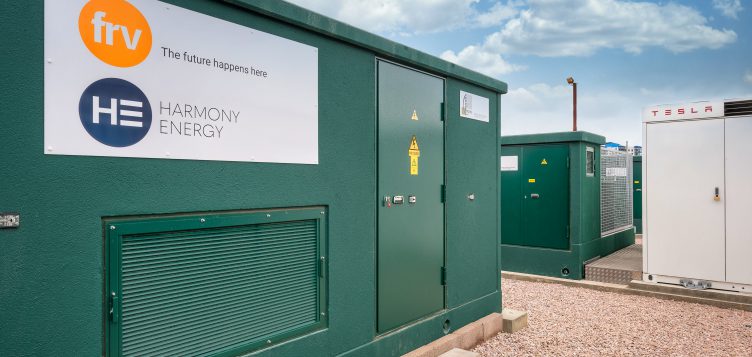
We can also celebrate FRV’s 540 GWh renewable energy plant in Chile, its batteries designed to supply 24/7 electricity for 224,000 homes. Being a hybrid plant, the Chilean project also demonstrates the second catalyst of the green energy revolution: wind power.
Wind – a force to be reckoned with
As a source of energy for industry and homes, wind is a wow for all the right reasons. It’s cheap, it’s clean and it’s limitless. The numbers speak for themselves:
- An extra 330 GW of wind power expected to come online between now and 2023 bringing global capacity to more than 900 GW[12]
- The Americas forecast to install more than 220 GW new capacity between now and 2024[13]
- Europe tipped to host 320 GW of wind power by 2030 meeting almost a quarter of its energy needs and creating hundreds of thousands of new jobs[14].
The industry has its sights set on full speed ahead, as outlined our Perspectives article on the potential of wind power.
Look at the 6 GW Ulanqab wind farm in China, a US$ 6.2 billion project set to cover 3,800 square km of Inner Mongolia, targeting a launch in time to help power the 2022 Winter Olympics. Or the US$ 500 million Dumat Al Jandal development in the Al Jouf region of Saudi Arabia, a landmark for wind power in the Middle East. The 400 MW Dumat Al Jandal should be powering up to 70,000 by 2022.
A sure sign of which way the wind is blowing.
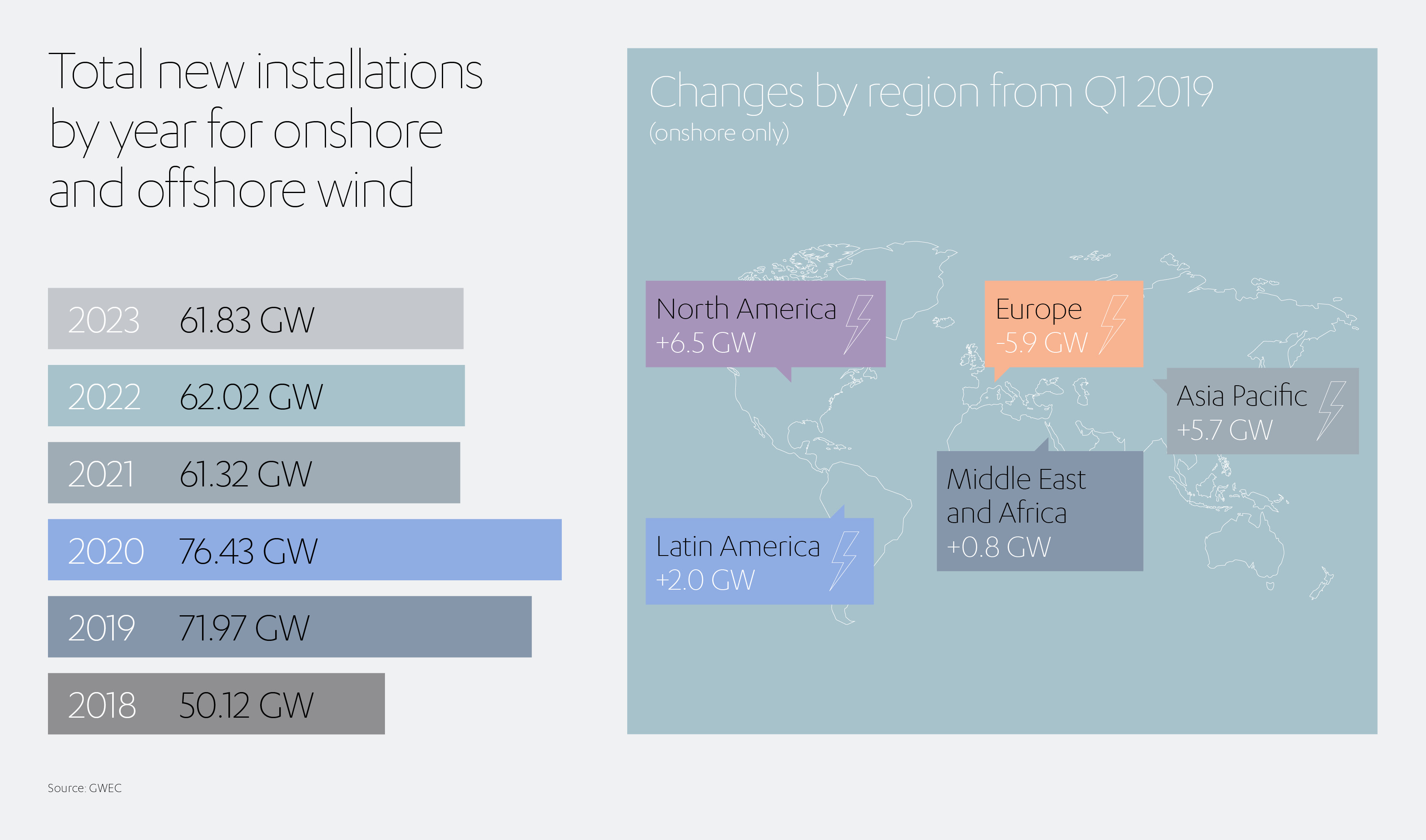
Floating ideas for an offshore revolution
Offshore wind farms are tipped to double their share of the wind market between now and 2023 from 9% to 18% – twice the growth rate of onshore wind.[15]
Europe witnessed ten new offshore wind farms totaling 3.6 GW of power in 2019 alone, with average sizes rising from 300 MW to 600 MW[16].
In the USA, plans are being laid for the world’s largest ever seaborne wind farm, with the expansion of the Coastal Virginia Offshore Wind Project. That facility will pump out 2.64 GW of power by 2026.
Why this massive investment in offshore wind? Again, cost is king.
While offshore wind remains a more expensive venture than onshore wind due to higher installation and maintenance costs, the gap is narrowing due to larger turbines and economies of scale. Further offshore cost reductions of anywhere from 30% to 50% can be expected in the future, making wind power an even more enticing prospect for investors.[17]
Upcoming technical innovations include new materials and construction techniques to create taller and ever-more efficient turbines. At the forthcoming Dogger Bank, UK farm, set to go live in the early 2020s, each turbine will be 220m high. And when it comes to wind turbines, height really matters. A 170m turbine, for instance, has a 35% greater energy yield than a 70m turbine[18].
A real breath of fresh air for the green energy economy.
Super powers can be truly heroic
The fortunes of renewable energies are firmly linked to government support.
Concerns were raised in America, for instance, when new solar projects were delayed by corporate tax reforms which knocked confidence in the price of PV modules. China, too, saw a solar slowdown blamed by the IEA on the government axing feed-in tariffs. Yet when future-focused policy prevails, investment follows – as we know from experience.
Chile’s renewable-friendly regulations, for example, are turbo-charging FRV’s activity in South America. We’re also exploring opportunities in Uruguay, Brazil, Peru and Colombia due to similarly renewables-friendly policies across neighboring countries.
Bilateral Power Purchase Agreements (PPA) are set to increase appetites exponentially for renewable investments. These PPAs will define the revenue and credit quality of wind projects globally, helping financiers back them with confidence[19].

Managing Director
FRV-X
As industry leaders in the green energy arena we’re passionate about securing political support for renewables in all corners of the globe.
“We are already collaborating with governments, regulators, and partners around the world to lay the foundations for a new energy model,” says Felipe Hernández, Managing Director Engineering and Asset Management at FRV.
We’re giving the green light to clean energy
Whether harnessing the power of the sun or unleashing the potential of the wind, at Abdul Latif Jameel we know that the future of energy is resoundingly renewable. That’s why we’re now active across 18 countries and have busily increased our project pipeline by 50% in less than two years.

Supporting our commitment to economic development, we are also committed to creating a meaningful legacy wherever we operate. This means creating jobs at all levels and training local workers to improve countries’ renewable energy expertise.
Decarbonizing the energy sector must be a priority for us all. If this really is ‘Year Zero’ of the climate apocalypse, now’s the time to stop the clock.
“There are many choices we can make today that will affect whether we can be close to a zero-emissions energy system in 2050. Making those right choices will ultimately help to drive the economy, protect the environment and safeguard our societies in future,” says Fady Jameel, Deputy President and Vice Chairman of Abdul Latif Jameel.
[1] https://www.epa.gov/ghgemissions/sources-greenhouse-gas-emissions
[2] https://www.eia.gov/todayinenergy/detail.php?id=41433
[3] https://www.theguardian.com/commentisfree/2019/dec/20/2019-has-been-a-year-of-climate-disaster-yet-still-our-leaders-procrastinate
[4] https://www.cdp.net/en/research/global-reports/global-climate-change-report-2018/climate-report-risks-and-opportunities
[5] https://www.ilo.org/wcmsp5/groups/public/—dgreports/—dcomm/—publ/documents/publication/wcms_711919.pdf
[6] https://www.worldbank.org/en/topic/climatechange/overview
[7] https://www.worldbank.org/en/topic/climatechange/overview
[8] https://www.iea.org/reports/renewable-energy-market-update/2020-and-2021-forecast-overview
[9] http://helioscsp.com/dewa-reviews-construction-of-4th-phase-of-the-mohammed-bin-rashid-al-maktoum-solar-park/
[10] https://www.powermag.com/iea-world-energy-outlook-solar-capacity-surges-past-coal-and-gas-by-2040/
[11] https://about.bnef.com/blog/energy-storage-investments-boom-battery-costs-halve-next-decade/
[12] https://gwec.net/press-release-q3-market-intelligence-update-2019/
[13] https://gwec.net/americas-wind-installations-rise-12-in-2019-to-13-4gw/
[14] https://www.ewea.org/fileadmin/files/library/publications/reports/EWEA-Wind-energy-scenarios-2030.pdf
[15] https://gwec.net/press-release-q3-market-intelligence-update-2019/
[16] https://windeurope.org/newsroom/press-releases/europe-installs-a-record-3-6-gw-of-offshore-wind-in-2019/
[17] https://www.nanalyze.com/2019/05/wind-energy-stock-wind-power/
[18] https://buildingspecifier.com/wind-turbines-set-to-reach-mega-heights-with-new-techniques/#
[19] https://gwec.net/press-release-q3-market-intelligence-update-2019/





 1x
1x

 Added to press kit
Added to press kit

